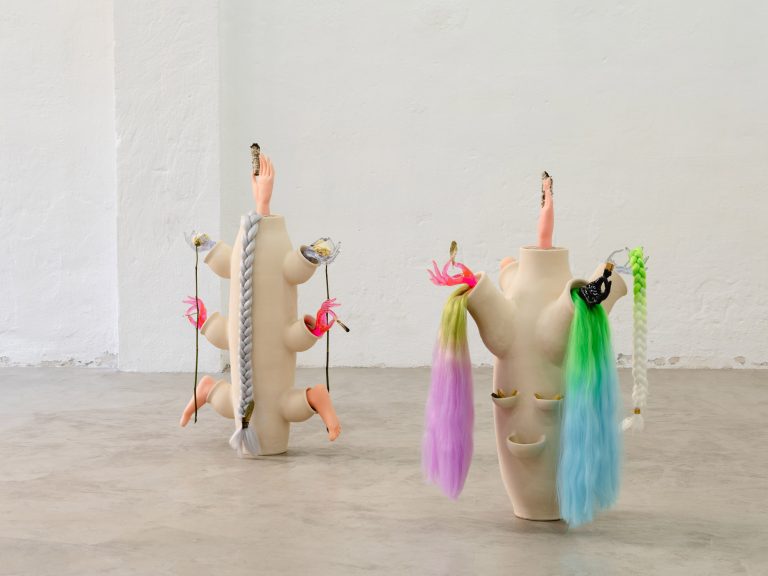Artists: Agata Ingarden, Anna Solal, Belén Zahera
Exhibition title: Scientific Romance
Venue: Yaby, Madrid, Spain
Date: July 14 – 30, 2017
Photography: Alberto Vallejo, all images copyright and courtesy of the artists and Yaby, Madrid
After the publication of Robert Chamber’s Vestiges of the Natural History of Creation in 1844, some critic defined it as a “scientific romance”. The book was a slightly speculative treaty on natural history addressing the transformation of species. Darwin found Chamber’s work lacking in scientific rigour, but nevertheless acknowledged its ability to bring a shocked social body if only a bit closer to the then very distant concept of transformation in biology. Chamber may have had let his “bad” science get seduced by the seductiveness of a more creative writing —of speculation, of fiction—, but his romancing of natural history also prepared the mindset of Victorian society for the future apparition of the theory of evolution that would be delivered only a few years later by Darwin—who had the chance of seeing in advance, through the critical reception of Chamber’s scientific romance, just which obstacles were in the way the commonsensical assumption of his radically new image of the natural world.
From those years on, the term scientific romance became widely used in referring the whole genre of science fiction. This archaic tag engenders a productive tension created by the collision of the two very differentiated worlds that conform it. On the one hand, the “hard” sciences and their razorsharp methodologies, profiling particular versions of realism that span from an empirical testing of the world to the construction of limiting frameworks of thought in late capitalism. On the other, romance, which in nineteenth century parlance meant a certain non-realist narrative, generally related to the extraordinary and the imaginary, presenting cognitive activity instead as an active reflection on the world that often derived in its invention. An affaire of fiction, speculation or art with science might turn out to be enriching in ways not evident to the scientific discipline itself: in The Concept of Non-Photography, François Laruelle already describes art as “the non-scientific use of science”, “a use outside the totality of its conditions of validity or knowledge relation.” Taking such a polarized yet intimate encounter as its point of departure, Scientific Romance actively reflects on the promise of an effort in epistemic porosity towards the expansion of our ability to make claims on reality, and ultimately —like Chamber’s treaty— towards making space for unexplored applications of the lethargic concept of transformation.
Scientific Romance, 2017, exhibition view, Yaby, Madrid
Scientific Romance, 2017, exhibition view, Yaby, Madrid
Scientific Romance, 2017, exhibition view, Yaby, Madrid
Anna Solal, Birds on Sky, 2017
Belén Zahera, Surface breeding II (Heraclius, Callias), 2017
Belén Zahera, Surface breeding II (Heraclius, Callias), 2017
Belén Zahera, Surface breeding II (Heraclius, Callias), 2017
Belén Zahera, Surface breeding II (Heraclius, Callias), 2017
Agata Ingarden, a bottle with no cap, 2017
Agata Ingarden, a bottle with no cap, 2017
Agata Ingarden, a bottle with no cap, 2017
Scientific Romance, 2017, exhibition view, Yaby, Madrid
Anna Solal, Bed, 2017
Anna Solal, Black Birds, 2017




















